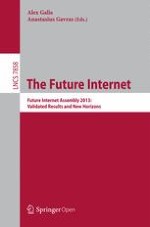Co-editors of the volume are:
Federico Álvarez, Alessandro Bassi, Michele Bezzi, Laurent Ciavaglia, Frances Cleary, Petros Daras, Hermann De Meer, Panagiotis Demestichas, John Domingue, Theo G. Kanter, Stamatis Karnouskos, Srdjan Krčo, Laurent Lefevre, Jasper Lentjes, Man-Sze Li, Paul Malone, Antonio Manzalini, Volkmar Lotz, Henning Müller, Karsten Oberle, Noel E. O'Connor, Nick Papanikolaou, Dana Petcu, Rahim Rahmani, Danny Raz, Gaël Richards, Elio Salvadori, Susana Sargento, Hans Schaffers, Joan Serrat, Burkhard Stiller, Antonio F. Skarmeta, Kurt Tutschku, Theodore Zahariadis
The Internet is the most vital scientific, technical, economic and societal set of infrastructures in existence and in operation today serving 2.5 billion users. Continuing its developments would secure much of the upcoming innovation and prosperity and it would underpin the sustainable growth in economic values and volumes needed in the future. Future Internet infrastructures research is therefore a must.
The Future Internet Assembly (FIA) is a successful conference that brings together participants of over 150 research projects from several distinct yet interrelated areas in the European Union Framework Programme 7 (FP7). The research projects are grouped as follows: the network of the future as infrastructure connecting and orchestrating the future Internet of people, computers, devices, content, clouds and things; cloud computing, Internet of Services and advanced software engineering; the public-private partnership projects on Future Internet; Future Internet Research and Experimentation (FIRE).
The 26 full papers included in this volume were selected from 45 submissions. They are organized in topical sections named: software driven networks, virtualization, programmability and autonomic management; computing and networking clouds; internet of things; and enabling technologies and economic incentives.
